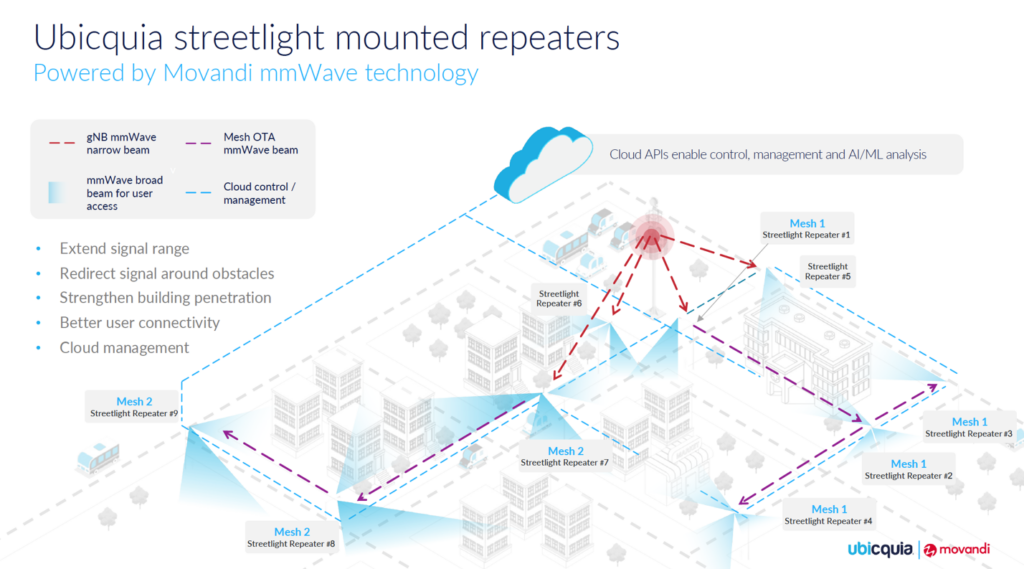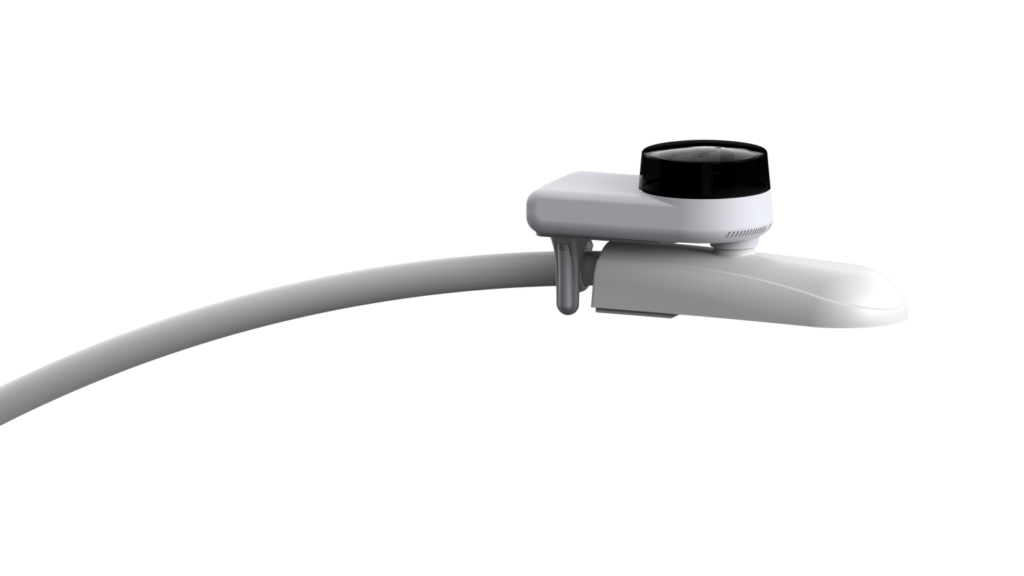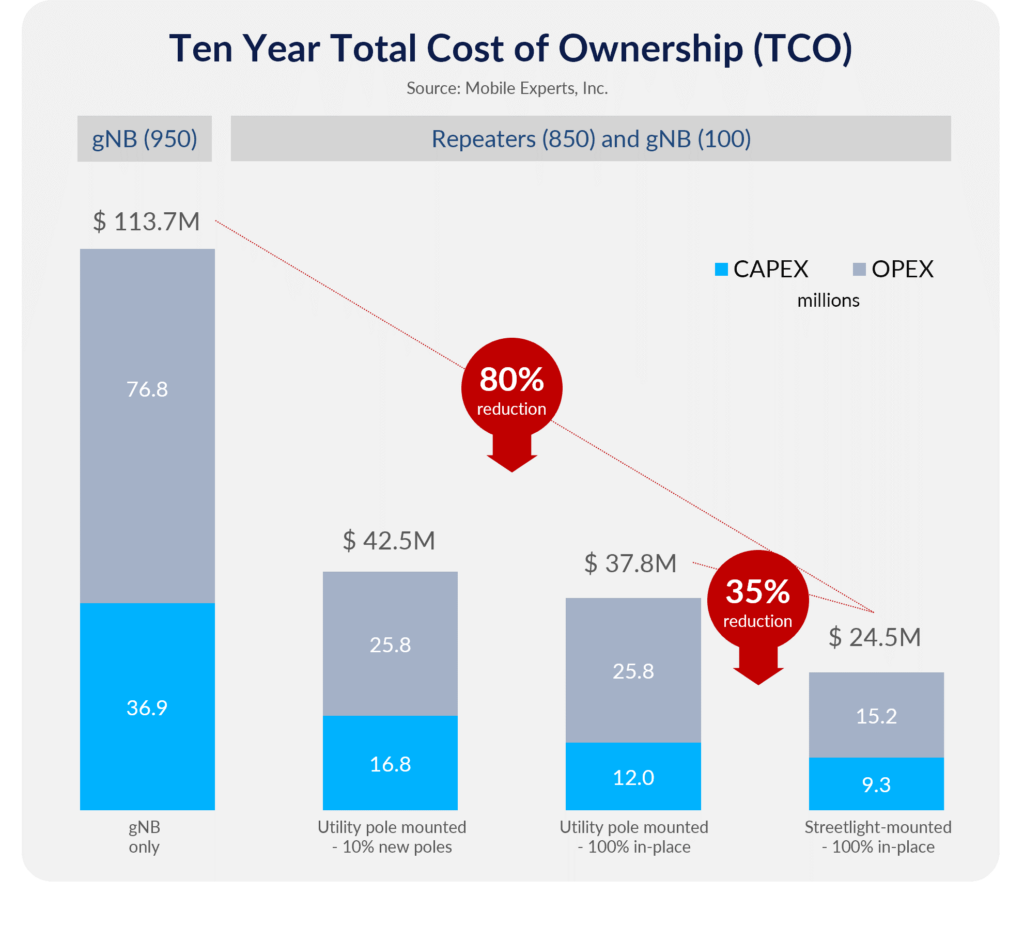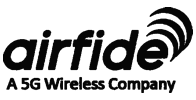Innovative streetlight mounted smart repeaters estimated to reduce TCO by 80%
There’s good reason why top US mobile operators recently invested nearly $4.5 billion to acquire millimeter wave (mmWave) 5G licenses in the 37 GHz, 39 GHz and 47 GHz bands in what may be the FCC’s largest spectrum auction to date. Market leadership in 5G hinges on feeding the need for speed, and mmWave frequencies provide the gigabit-per-second throughput and super-fast data rates that consumers and businesses alike expect from 5G but aren’t getting from sub-6 GHz networks.
Sub-6 GHz speeds can slow down considerably when large numbers of mobile devices are connecting to the network. In contrast, mmWave technology can deliver up to 100x more capacity and much greater bandwidth than current 5G sub-6 GHz spectrum, relieving network congestion and enabling a broad set of applications. However, mmWave network deployment faces propagation and coverage challenges: The typical distance a mmWave signal can travel is less than 250 meters and don’t turn corners or penetrate barriers such as walls and buildings. As a result, 5G mmWave networks require many more sites – small cells, distributed antenna systems (DAS) and repeaters – than mid-band networks to overcome propagation and line-of-sight (LOS) challenges.
A common way to expand mmWave coverage is to deploy large numbers of small cells and repeaters. Small cells can be deployed to add capacity because they’re less expensive than erecting new towers, but they still require fiber connectivity which is costly with complex permitting. Smart repeaters provide an attractive alternative to gNodeBs or small cells because they can extend mmWave coverage without the need for fiber runs reudicng cost and deployment complexity. This approach, however, creates challenging deployment economics for mmWave networks, especially in less densely populated areas. Mounting a radio and laying fiber in the field can be a complex, costly endeavor. Local jurisdictions maintain strict rules about device size and power consumption. Digging trenches in urban areas for fiber is labor intensive and disruptive, and providing electrical power further complicates deployment.
To reduce the cost and complexity of deploying mmWave networks, Ubicquia, a provider of intelligent, simple-to-deploy infrastructure platforms, and Movandi have joined forces to deliver a smart repeater solution that can be mounted easily and cost-effectively on modern LED streetlights.
LED streetlights can now perform the double duty of beaming light to illuminate cityscapes and mmWave signals to expand radio access network (RAN) coverage in urban areas. This novel approach avoids most of the logistical headaches, delays and costs associated with deploying 5G repeaters in conventional locations such as walls and traffic and utility poles. Operators can save time and money in site acquisition, site set-up and network deployment, reducing total cost of ownership (TCO) and accelerating broad coverage and ROI.
The new Ubicquia streetlight repeaters incorporate Movandi’s proven mmWave 5G technology and reference design platforms including RF semiconductors, custom phased-array antenna modules, algorithms and software including cloud APIs for management, control and AI/machine learning data analytics. Designed to support all global mmWave spectrum bands, the Ubicquia repeaters integrate seamlessly with major RAN/Open RAN technologies from leading 5G equipment vendors worldwide including Ericsson, Huawei, Nokia and Samsung.
The Movandi and Ubicquia collaboration transforms the economics of deploying 5G networks by mounting mmWave repeaters on existing LED streetlights. The Ubicquia smart repeaters are compatible with an estimated 360 million streetlights worldwide including an estimated 65 million streetlights in the US. Most of these streetlights have been outfitted with efficient LED lighting. Typical LED upgrades save more than 150 Watts per streetlight over antiquated sodium lamps while leaving ample power for radio devices such as repeaters and low-power small cells.
The Ubicquia repeaters are designed to leverage the convenient 50-meter spacing, standard 8- to 10-meter heights and built-in power supplies of LED streetlight infrastructure. This innovative approach makes millions of site-ready repeater locations available to operators at a fraction of the time and cost of installing new utility poles for 5G base stations and running fiber to them.
Technicians can easily install a streetlight-mounted smart repeater in minutes. The repeater simply plugs into the streetlight’s existing photocell. In fact, the Ubicquia solution can shrink the time required to install a mmWave repeater to a 15-minute stop, requiring less than 30 seconds to actually install the repeater in a standardized LED light socket. See a video about the installation process here.
Barely visible at street level, Ubicquia’s streetlight repeaters are discrete and unobtrusive in dense urban settings. A network of these streetlight-mounted mmWave repeaters ensures optimal outdoor coverage and enhanced user experiences by extending the range of 5G mmWave gNBs and redirecting signals around obstacles such as walls and buildings. Cloud-based configuration and management make the repeater deployments fast and simple, requiring just one truck roll to the light pole for the initial installation.
According to a recent study published by Mobile Experts, Inc., the Ubicquia streetlight repeater solution can reduce operator TCO by 80 percent. Mobile Experts compared the economics of streetlight-mounted repeaters with the conventional approach of mounting repeaters on utility poles, traffic poles and walls and determined that mmWave deployment can be significantly streamlined by taking advantage of standard photocell sockets on LED streetlights.
“For any outdoor radio deployment, streetlight photocell sockets present an incredible opportunity to speed up the process and save money,” concluded Joe Madden, founder and president of Mobile Experts. “This is especially obvious in the case of repeaters, where power consumption is low and no fiber is needed. Our conclusion: Streetlight deployment is absolutely the way to go. The cost savings are significant, but more importantly, the radios can be on the air extremely quickly.”
To learn how Ubicquia’s and Movandi’s streetlight-based repeater solution can accelerate global 5G mmWave coverage and deliver on the promise of high-speed, low-latency 5G services, download the new Mobile Experts white paper, Streetlight Mounted mmWave Radios Transform Coverage Economics, and visit Movandi products.










